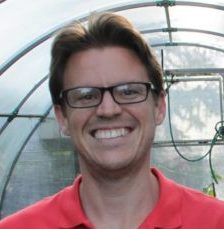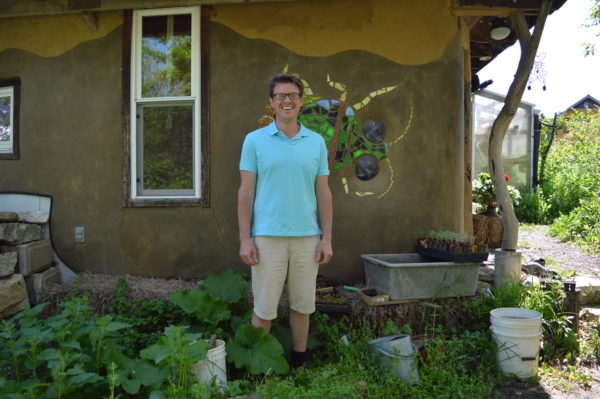Using the Land Well and Lovingly: A Dancing Rabbit Experience
Published: Sun, 06/02/19

By Avi Maistri
Greetings from Dancing Rabbit, which is frost-free now that spring is in full swing. Avi here, no longer worrying about whether my frost-vulnerable crops will be unexpectedly exposed to a late chill. I’m learning to navigate the natural rhythms of Northeast Missouri, and I’m grateful for my more experienced neighbors, who are often available to offer me sage wisdom on how to better inhabit this land in a mutually restorative way.
Like the vast majority of us making our lives here at Dancing Rabbit, I didn’t grow up in Northeast Missouri. Nope; I’m from suburban South Florida, near West Palm Beach, where there are no winters, and a day in the Atlantic’s bathwater is a viable option 11 months out of the year. In addition to those seductively alluring climate advantages, there were many disadvantages to growing up in South Florida for me, many of them stemming from the realities of living in an overcrowded part of the country — it turns out my family wasn’t the only one stoked to head south and leave Northeastern winters behind.
Among the drawbacks of living in a relatively anonymous, low-trust culture is that codes and laws rule the day, while interpersonal interaction and sharing are limited. Everyone has their own everything, and you’d be hard pressed to find a neighborhood that doesn’t fall under the jurisdiction of a controlling Home Owners Association (HOA) that values uniformity and property value over even the smallest displays of self-reliance and personal expression. (Think lawns, not gardens, and getting your car towed without warning for parking in the wrong place at the wrong time — within your own apartment complex.)
South Florida’s uncooperative transplant culture left me wanting for some crucial aspects of my own human development. Like many urban and suburban millennials, I suffered from a lack of community. Symptoms included a lack of connection with the land and natural world, a lack of day-to-day mentorship, and social isolation. As I grew older my inability to afford expensive property and legally make my own relationship to that property, and a lack of communal collaboration sent me searching far and wide for a place on Earth where I could realize my dream of living close to the land, immersed in the natural world as a component part.
At the beginning of April, I moved back to Dancing Rabbit, where I had lived for a short time a few years ago, with an eye toward putting down roots and raising a family with my wife Anna. When I think about the reasons we came, and the reasons we’re likely to stay, I land firmly on things like: affordable land access, freedom to create a relationship with that land in a way that expresses our values, and an abundance of mentorship in the lifestyle we want to live. Here, we can collaborate on lots of things: gardening, sharing tools and vehicles, and much more. We also have opportunities to learn about a wide variety of topics that interest us, such as planning a full-season garden, rotational grazing practices, and artisan cheese making. (The best way to get a taste of of Dancing Rabbit’s culture, and learn some ways you too can change your life for the better, is to sign up to attend our visitor program.)
Dr. Joshua Lockyer, Associate Professor of Anthropology at Arkansas Tech University and board member of the Center for Sustainable and Cooperative Culture at Dancing Rabbit Ecovillage, recently published an article called “Community, Commons, and Ecological Restoration at Dancing Rabbit Ecovillage” in which he attempts “… to show how a group of ecovillagers is demonstrating that effective commons management is possible today … ” and “… explore their efforts to simultaneously restore prairie ecosystems and develop productive human landscapes through cooperative stewardship of their collectively held acreage.” For me, it’s an article about how cooperative property management can help to create a local culture that prioritizes the restoration of local ecosystems, while simultaneously building a human landscape that yields a quality of life higher than overcrowded concrete jungles or isolated subsistence farms.
Josh ends the article with a beautiful, poignant quote from Wendell Berry: “The loss of local culture is, in part, a practical loss and an economic one. For one thing, such a culture contains, and conveys to succeeding generations, the history of the use of the place and the knowledge of how the place may be lived in and used. For another, the patterns of reminding implies affection for the place and respect for it, and so, finally, the local culture will carry the knowledge of how the place may be well and lovingly used, and also the implicit command to use it only well and lovingly. The only true and effective ‘operator’s manual for spaceship Earth’ is not a book that any human will ever write; it is hundreds of thousands of local cultures.”
By these standards, suburban South Florida is at a significant loss of local culture. Perhaps a reason our communities, and our planet, are so poorly taken care of today is because global urbanization, with all its technological advances, has sweepingly replaced local cultures that teach successive generations how to use their land well and lovingly.
Finding Dancing Rabbit has shown me that even without having grown up in an intact local culture, it’s never too late to become a part of one. All hope is not lost.
If you’re like Avi and Anna, and you’ve been yearning to have a sense of community, as well as a connection to the natural world, then it’s time to stop fantasizing and do something to make your dream a reality, just like they did. The first step is to sign up for our visitor program. Don’t let someone else take advantage of a life-changing opportunity that should have been yours, just because you sat on the fence too long.
 Avi likes to spend his time at Dancing Rabbit gardening with his wife Anya, doing administrative and programs work for the Center for Sustainable and Cooperative Culture, making cheese, and chasing frisbees. He also teaches English as a second language online.
Avi likes to spend his time at Dancing Rabbit gardening with his wife Anya, doing administrative and programs work for the Center for Sustainable and Cooperative Culture, making cheese, and chasing frisbees. He also teaches English as a second language online.
